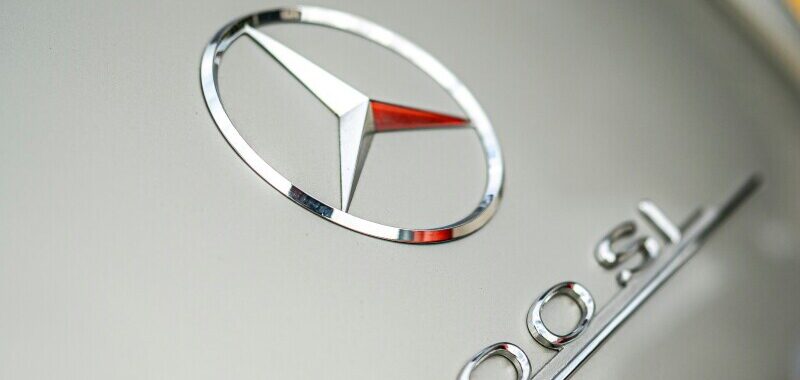
Owning a classic Mercedes is all about preserving its timeless beauty and elegance. Over the years, though, small scratches, chips, or fading paint can take away from that pristine look. Luckily, touch-up painting can work wonders, helping restore your Mercedes’ charm without the need for a full repaint. This guide will take you through the art of touch-up: painting your classic Mercedes, making it easy and enjoyable to enhance your car’s appearance.
Mercedes-Benz isn’t just a car brand; it’s a statement of luxury and innovation that has been turning heads for decades. Started in the late 19th century, Mercedes-Benz has always been at the forefront of automotive engineering and design, promising style and unmatched performance. It’s no wonder car enthusiasts and collectors hold these classic models in such high regard.
Classic Mercedes models carry a certain flair that newer cars often struggle to replicate. The lines, the chrome accents, and even the smell of the leather interiors are like a time capsule, instantly transporting you to a different era. Whether it’s the sleek contours of the 300 SL Gullwing from the ’50s or the stately elegance of the ’80s E-Class, each model has its unique charm that captivates collectors worldwide.
Many classic Mercedes models, like the 280 SL ‘Pagoda’ or the 190 SL, are standout examples of the brand’s ability to mix beauty with brawn. Appreciators of these models often talk about the blend of aesthetics and reliability—a combination that’s not just rare; it’s magical.
There’s a strong emotional connection for those who own or desire a classic Mercedes. These cars aren’t just vehicles; they’re passionate projects, bonded with memories of past road trips, garage tinkering, or some inherited family heirloom. They signify a person’s deep appreciation and longing for the craftsmanship of the bygone days of motoring.
Diving into a touch-up job for your classic Mercedes can be a rewarding project, but it’s crucial to approach it with care to keep its value intact. These timeless machines deserve a bit of love to maintain their original charm, and touching up the paint is a perfect way to enhance that classic beauty without compromising authenticity. So, Let’s roll step by step!
Deciding between a DIY approach or calling in the pros is often a tough decision. Consider your confidence and experience level first. If it’s your first attempt, starting on less visible areas is wise. For larger or trickier jobs, a professional’s expertise can sometimes make all the difference, ensuring the final result is as flawless as the car itself.
Step 1: Gather Your Touch-Up Painting Tools
Why It Matters: Having the right tools ensures a smooth, even finish and prevents issues that could make the touch-up stand out.
What to Do: Make a checklist of essential supplies, including:
- Touch-up paint: Match your car’s exact color code.
- Primer: Creates a base layer for better paint adhesion.
- Clear coat: Seals the paint and provides a glossy finish.
- Sandpaper (fine grit): Smooths out imperfections.
- Microfiber cloths: For cleaning and buffing.
- Paint applicators: Small brushes or paint pens for precision.
Resources:
- Touch-Up Paint Matching: Check Mercedes-Benz USA to locate your car’s exact paint code.
- Automotive Paint Suppliers: Websites like AutomotiveTouchup offer high-quality touch-up paint that matches Mercedes colors.
Step 2: Clean and Prepare the Area
Why It Matters: Dirt, dust, and oils can prevent paint from adhering properly, making preparation a crucial step.
Setting the stage for a successful paint job means finding the perfect space. Look for a well-ventilated area free from dust and debris. A tidy and controlled environment helps avoid those pesky particles from sneaking into your fresh paint. If possible, work when humidity levels are low to ensure a smooth application.
What to Do:
- Wash the area around the scratch or chip with a gentle car wash soap.
- Use rubbing alcohol on a microfiber cloth to remove any oils or residues left by your hands or cleaning products.
- Dry the area completely before moving to the next step.
Resources:
- Car Wash Soap: Meguiar’s offers gentle, paint-safe car wash solutions.
- Microfiber Cloths: Affordable and effective microfiber towels are available on Amazon.
Step 3: Sand the Damaged Area Gently
Why It Matters: Sanding smooths the surface, ensuring an even application of paint and primer.
What to Do: Use very fine-grit sandpaper (1000-2000 grit) to gently sand the area around the scratch or chip. Avoid sanding beyond the damaged area to prevent unnecessary wear. Your goal is to even out the surface without going too deep.
Tip: Use light pressure and check frequently to avoid over-sanding, especially on delicate, vintage paint.
Resources:
- Fine Grit Sandpaper: Available on Harbor Freight or at local hardware stores.
Step 4: Apply Primer for a Lasting Finish
Why It Matters: Primer acts as a foundation, helping the paint adhere well and providing a more durable finish.
What to Do: Using a fine-tip brush, apply a small amount of primer only to the sanded area. Allow it to dry completely before applying any paint (usually 30 minutes to an hour, depending on the product).
Tip: Follow the instructions on your primer for drying time recommendations.
Resources:
- Automotive Primer: Eastwood offers high-quality primers suited for touch-up work on classic cars.
Step 5: Carefully Apply the Touch-Up Paint
Why It Matters: Precision is key to blending the touch-up paint with the original color, preventing it from looking patched.
What to Do:
- Shake the touch-up paint well to ensure even color.
- Using a fine brush or paint pen, apply the paint in thin, even layers, focusing only on the damaged area.
- Allow each coat to dry before adding another, as multiple light coats create a smoother finish than one thick layer.
Tip: Practice applying the paint on a scrap surface first to get a feel for the brush or pen’s flow.
Resources:
- Paint Pens and Brushes: Check AutomotiveTouchup for a variety of applicators suitable for small touch-up jobs.
Step 6: Apply Clear Coat for Shine and Protection
Why It Matters: Clear coat provides a glossy finish and adds a protective layer to prevent future damage.
What to Do: Once the paint is fully dry, apply a thin layer of clear coat using a fine brush or applicator. Let it dry and, if needed, apply a second coat for a smoother, more polished look.
Tip: Avoid touching the clear coat while it dries, as fingerprints can leave marks that are hard to remove.
Resources:
- Clear Coat Options: Dupli-Color offers automotive clear coats designed for touch-up applications.
Step 7: Lightly Sand and Polish for a Seamless Finish
Why It Matters: This final sanding and polishing step helps the new paint blend seamlessly with the original, making the touch-up less noticeable.
What to Do: After the clear coat has fully cured (usually 24-48 hours), gently wet-sand the area with 2000-3000 grit sandpaper. Use a polishing compound and a microfiber cloth to buff the area for a smooth, even shine.
Tip: Avoid sanding too hard. A light hand and patience will yield the best results.
Resources:
- Polishing Compounds: 3M Scratch Remover is a great choice for buffing out small imperfections.
Step 8: Protect the Paint with Wax
Why It Matters: A good layer of wax not only enhances the shine but also protects the paint from UV rays, dust, and minor scratches.
What to Do: Apply a high-quality car wax over the newly painted area and buff it out using a microfiber cloth. Regular waxing can help maintain your car’s finish and keep it looking fresh.
Tip: Wax the entire car every few months to keep the paint protected and shiny.
Resources:
- Car Wax Options: Turtle Wax and Meguiar’s offer high-quality waxes that are easy to apply and provide lasting protection.
Step 9: Regular Maintenance for Long-Lasting Results
Why It Matters: Regular maintenance keeps your car’s paint in great condition and prevents future scratches and chips from worsening.
What to Do: Wash your car regularly using a gentle, non-abrasive soap and a soft sponge. Avoid parking under trees or near areas with loose gravel to reduce the chances of chips and scratches. If new damage does occur, it’s easier to address it sooner rather than later.
Resources:
- Maintenance Tips: Mercedes-Benz USA has a section on care tips for Mercedes owners, including paint protection.
Wrapping Up The Art Of Touch-Up: Painting Your Classic Mercedes
Touching up the paint on your classic Mercedes is a rewarding process that can make a big difference in the car’s appearance and value. With the right tools, a bit of patience, and careful attention to detail, you can restore your car’s original charm without the expense of a full repaint.
By following these steps, you’ll enjoy a professional-looking finish that blends seamlessly with the original paint, allowing your classic Mercedes to shine like the day it left the showroom.

Hello,
I really enjoyed reading this guide on touching up the paint on a classic Mercedes! It’s clear that owning a vintage Mercedes isn’t just about having a car – it’s about preserving a piece of automotive history. The step-by-step instructions make the whole touch-up process seem more approachable, even for someone who’s never tried it before. I especially liked the emphasis on using the right tools and taking your time with each step. It’s so easy to rush through these kinds of projects, but this guide reminds me that attention to detail is key when restoring a car’s beauty. The tips on choosing between DIY and professional help were also really helpful. Overall, I feel more confident tackling a touch-up project now, and it’s great to know I can maintain the car’s value while keeping it looking sharp!
Thank you for your comment! You’re right; owning a classic Mercedes is more than just car ownership; it’s about living the history and craftsmanship. It’s beautiful to hear that the guide made the touch-up process more approachable and gave you the confidence to take on such a rewarding project.
Taking the time to use the right tools and follow each step carefully is the secret to achieving professional-looking results. It’s great that you appreciated the balance between DIY and professional help; knowing when to handle things yourself and when to call in an expert is always empowering. With your attention to detail and newfound confidence, your Mercedes will continue to turn heads while maintaining its value. Best of luck with your touch-up project!